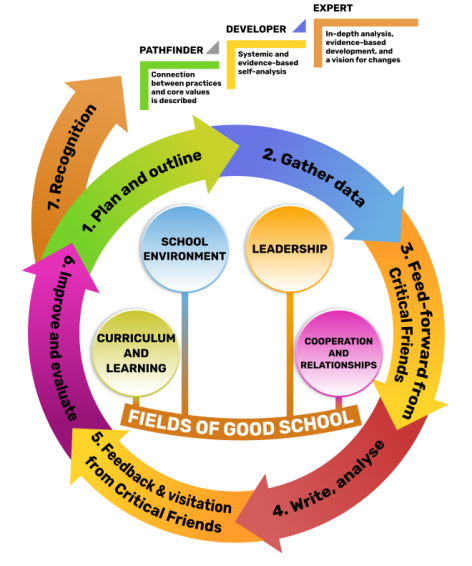Good School Model
The Good School model comprises four areas of school life. The aspects have been divided into four areas and the division is based on the internal evaluation report of Estonian schools.
Image

CURRICULUM AND LEARNING
- Teacher creates interesting, joyous and student-led learning process
- School staff works towards ascertaining the individual needs of each student and takes these into account in the teaching and education work
- Teachers cooperate with each other
- Subjects are interrelated
- Enthusiastic learning i.e. motivation to learn is supported
- Study tasks are related to practical life
- Teachers apply grading principles that support learning i.e. formative assessment
- Individual feedback to learning and student behaviour is provided consistently
- Students are offered a diverse range of extracurricular activities
- After-school activities (class trips, fairs, family days and other events) have been thought through
- Mistakes are seen as learning opportunities
- Conscious value education:
- fostering creativity,
- initiative,
- consideration of others,
- one's responsibility before the society and homeland and
- respect to all living creatures.
SCHOOL ENVIRONMENT
- School life is interesting and supports flourishing of each member of school family (i.e. student, teacher, supporting staff, school board, parents)
- Creating an emotional atmosphere during lessons and outside lessons is supported
- The school building is warm and cosy
- Students are involved in creating the school environment
- Members of the school are united by feeling of ownership over their school and its traditions
- School environment ensures physical safety
- School environment ensures mental safety
- Healthy lifestyle of all the school members is promoted (including healthy eating, physical activity, work and rest balance, etc.)
- Special needs of school family members are taken into account
- Activities of students and other members of the school in the information society are supported: possibilities and dangers of the information society are introduced
LEADERSHIP
- Everyday activities at the school are based on consciously set goals and shared vision
- Values are developed systematically by taking into account that all the activities of a school should originate from agreed-upon values; values are daily expressed by the actions of teachers and the management
- The management is open, inspiring and fair and the head of school is a good role model for the entire school
- The head of school motivates the school staff and supports their development
- The management supports implementation of principles that foster learning
- The school staff receives meaningful feedback to their work
- The staff is informed of what is happening in the school
- The school staff is professional and development-oriented, engages in self-reflection and actively participates in trainings and learning communities in and outside of school
- The school is actively looking for additional resources to better the school environment
- Different parties are involved in planning the efficient use of resources (people, time, money etc.)
COOPERATION AND RELATIONSHIPS
- Different members of the school life cooperate:
- teachers-teachers,
- teachers-students,
- students-students,
- teachers-parents,
- teachers-management,
- parents - support staff,
- teachers - support staff,
- students - support staff,
- school - the community
- Various forms of cooperation are used
- The members of a school get along well and can overcome their differences
- Those who need help are noticed and helped
- The school cooperates with other schools or institutions to share their experiences, challenges, and joys
- Activities that support the learning and growth of parents and their habit of cooperating with the school are supported
- Students, teachers and other school staff members and parents manage and/or are involved in various school projects
- Information received in training courses is shared between colleagues via peer-to-peer learning
- The school has its own support staff that helps to solve problems
- Learning support is developed to prevent students from having problems with learning


